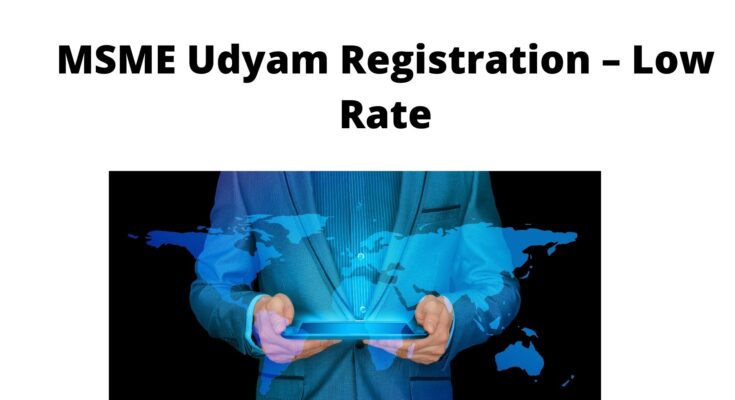In June 2020, the MoMSME gave a notice modifying the meaning of Micro, Small and Medium Enterprises (MSMEs) and presented another enrollment framework – the Udyam.
In any case, the numbers for the new Udyam enrollment framework stays low, and here is the reason.
What were the progressions made?
With impact from July 1, 2020, the updates in the MSME definition were three-crease:
the differentiation among assembling and administrations area MMSEs was taken out
an extra standard of turnover was presented
speculation limits were modified upwards
The warning additionally presented another method for enlistment as per the reconsidered MSME definition, under the Udyam framework.
How is the degree of enlistments?
As on March 31, 2021, which was the cutoff time for enrolling under the new Udyam framework, just 26.4 lakh ventures have enlisted.
This implies under 5% of the all out assessed MSMEs (6.33 crore) in the nation are Udyam enlisted now.
The past enlistment framework for MSMEs – the Udyog Aadhaar Memorandum (UAM) – had more enrollments.
Presented in 2015 and functional until June 2020, this framework had a little north of one crore enlistments.
This is around 16% of the assessed MSMEs.
Like the UAM framework, the Udyam framework is additionally liberated from cost, paperless and computerised.
A significant distinction is that under Udyam, when Aadhaar/PAN is given, all the pertinent annual expense and GST information can be pulled from the individual government data sets, at the backend.
In addition, a solitary enrollment is enough for a long time embraced by a similar undertaking.
What are the advantages under Udyam enlistment?
Endeavours who self-guarantee and achieve enlistment are qualified for specific advantages.
These range from being qualified for sponsorship plans like the Credit Linked Capital Subsidy Scheme (CLCSS) to enrolling grumblings with respect to deferred instalments on the MSME SAMADHAN gateway.
According to the RBI’s notice, from August 2020, loan specialists might request the Udyam enrollment for credit purposes.
The Udyam gateway is likewise coordinated with the Government e-Marketplace and the Trade Receivables and Discounting System (TReDS).
In this way, these endeavours can partake in government obtainment, and have a component for limiting their bills.
For what reason is the enlistment rate low then, at that point?
One explanation could be the previous necessity that organisations that needed to enrol under Udyam needed to give their GSTIN.
Since many organisations have a turnover of not as much as Rs 40 lakh and subsequently shouldn’t be GST consistent, it made them ineligible to enlist.
Such a prerequisite was eliminated by the MoMSME on March 5, 2021.
Notwithstanding, since the cutoff time for enlistment was March 31, 2021, this intercession might have discouraged numerous MSMEs from enrolling.
Of the absolute Udyam enlisted undertakings, just 2% are with GSTIN.
Another explanation could be the absence of mindfulness in regards to the new enrollment framework itself.
This is an overall perception while looking at low off-take of plans that are carried out for the area.
Low degrees of mindfulness with respect to the carry out of plans, their qualification conditions, administrative work prerequisites and complaint change systems sway generally off-take of these plans.
Another dreary however logical clarification could be that countless MSMEs have needed to slow down in the pandemic period.
In spite of strategy drives to give the area a fillip, lockdowns and interruptions in supply chains have had their own effect.
What will the ramifications be?
The destiny of near 6 crore unregistered elements stays questionable.
The inquiry remains whether they will be permitted to benefit from appropriations and other credit offices without a Udyam enrollment.
Need Sector Lending (PSL) bearings have not expressed an unequivocal necessity for a UAM or the Udyam number.
In any case, since the RBI has permitted loan specialists to request the Udyam enrollment for credit purposes, conceivably some might decide to do as such.
Given the previously blossoming credit hole in the area, loan specialists setting such prerequisites for a need area could additionally highlight the credit hole for MSMEs.
What next?
While the assumption is that the cutoff time will be expanded, the need to increase the execution of such significant drives couldn’t possibly be more significant.
Ten states in the nation represent 74% of the completely assessed MSMEs.
In expresses that make up the transcendent portion of MSMEs, the MSME-District Institutes and other field workplaces of the MoMSME should be roped in.
They should be entrusted with instructing and making mindfulness in regards to the Udyam framework, on fundamentally important premises.
Last-mile mindfulness with respect to frameworks and plans that can help MSMEs will be a fundamental stage towards connecting the endless access hole.


